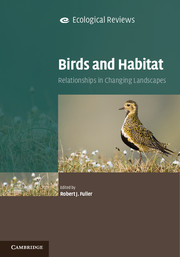Book contents
- Frontmatter
- Contents
- List of Contributors
- Preface
- Part I The complexity of patterns and processes
- Part II Case studies of habitat use and selection
- Part III Wider perspectives
- Chapter Fifteen What is habitat quality? Dissecting a research portfolio on shorebirds
- Chapter Sixteen Understanding individual life-histories and habitat choices: implications for explaining population patterns and processes
- Chapter Seventeen Insufficient adaptation to climate change alters avian habitat quality and thereby changes habitat selection
- Chapter Eighteen Australian birds in a changing landscape: 220 years of European colonisation
- Chapter Nineteen Birds in cultural landscapes: actual and perceived differences between northeastern North America and western Europe
- Chapter Twenty Birds and their changing habitat: thoughts on research and conservation strategies
- Species index
- Subject index
- References
Chapter Nineteen - Birds in cultural landscapes: actual and perceived differences between northeastern North America and western Europe
Published online by Cambridge University Press: 05 December 2012
- Frontmatter
- Contents
- List of Contributors
- Preface
- Part I The complexity of patterns and processes
- Part II Case studies of habitat use and selection
- Part III Wider perspectives
- Chapter Fifteen What is habitat quality? Dissecting a research portfolio on shorebirds
- Chapter Sixteen Understanding individual life-histories and habitat choices: implications for explaining population patterns and processes
- Chapter Seventeen Insufficient adaptation to climate change alters avian habitat quality and thereby changes habitat selection
- Chapter Eighteen Australian birds in a changing landscape: 220 years of European colonisation
- Chapter Nineteen Birds in cultural landscapes: actual and perceived differences between northeastern North America and western Europe
- Chapter Twenty Birds and their changing habitat: thoughts on research and conservation strategies
- Species index
- Subject index
- References
Summary
This chapter presents an intercontinental comparison of studies on bird–habitat relationships in three types of cultural landscapes: those created by forestry (managed forests), agriculture (farmed land and remnant native habitats in a matrix of farmed land) and urbanisation. The geographical emphasis is on temperate and boreal regions of eastern Canada (hereafter referred to as ‘North America’) and western Europe/Fennoscandia. We seek out differences and similarities in patterns and discuss responses of birds to processes of landscape change. We consider the influence of human perception of landscapes on the development of research ideas and the extent to which there has been intercontinental exchange and application of ideas and research findings.
One of the most striking differences in the history of habitats in North America and Europe often put forward is the timing and rate of land clearing. The clearing of a predominantly forested landscape has often been described as one of the major tasks European settlers faced arriving in North America (Whitney, 1994), whereas in Europe land clearing had started around 6000 years ago (Williams, 2003).
However, the common picture of eastern North America as a vast forested wilderness before European colonisation is coming into question. Aboriginal people probably managed the landscape quite extensively through permanent or shifting agriculture and the use of fire to clear land for cultivation, to create parklands favourable to game and to open forest understorey to facilitate travel (Williams, 2003, 2008). These managed landscapes disappeared with the annihilation of over 90% of aboriginal populations starting in the 1500s, mainly due to diseases transmitted by Europeans. In southern Ontario, for instance, the extent of forested lands probably reached a low just before these epidemics (Pyne, 1982; Williams, 1989).
- Type
- Chapter
- Information
- Birds and HabitatRelationships in Changing Landscapes, pp. 481 - 515Publisher: Cambridge University PressPrint publication year: 2012
References
- 7
- Cited by

